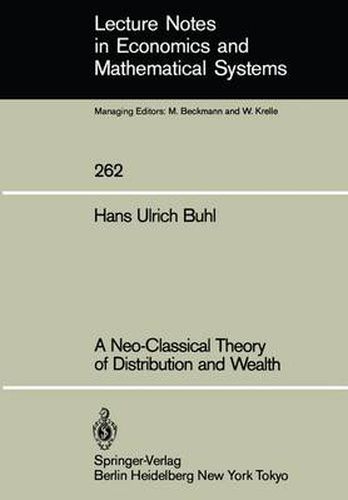Readings Newsletter
Become a Readings Member to make your shopping experience even easier.
Sign in or sign up for free!
You’re not far away from qualifying for FREE standard shipping within Australia
You’ve qualified for FREE standard shipping within Australia
The cart is loading…






This title is printed to order. This book may have been self-published. If so, we cannot guarantee the quality of the content. In the main most books will have gone through the editing process however some may not. We therefore suggest that you be aware of this before ordering this book. If in doubt check either the author or publisher’s details as we are unable to accept any returns unless they are faulty. Please contact us if you have any questions.
The distribution of capital and income in general and its re lation to wealth and economic growth in particular have attrac ted economists’ interest for a long time already. Especially the, at least partially, conflicting nature of the two politi cal objectives, namely to obtain substantially large economic growth and a just income distribution at the same time, has caused the topic to become a subject of political discussions. As a result of these discussions, numerous models of workers’ participation in the profits of growing economies have been developed. To a minor extent and with quite diverse success, some have been implemented in practice. It is far beyond the scope of this work to outline all these approaches from the past centuries and, in particular, the past decades. In economic theory many authors, for instance Kaldor [1955], Krelle [1968], [1983], Pasinetti [1962], Samuelson and Modigli ani [1966], to name but a few, have analyzed the long-term eco nomic implications of workers’ saving and investment. While most of this extensive literature is highly interesting, it suffers from the fact that it does not explicitly consider either workers’ or capitalists’ objectives and thus neglects their impacts on economic growth. Thus, in the framework of a neo-classical model, these objectives and their impacts will be emphasized here.
$9.00 standard shipping within Australia
FREE standard shipping within Australia for orders over $100.00
Express & International shipping calculated at checkout
This title is printed to order. This book may have been self-published. If so, we cannot guarantee the quality of the content. In the main most books will have gone through the editing process however some may not. We therefore suggest that you be aware of this before ordering this book. If in doubt check either the author or publisher’s details as we are unable to accept any returns unless they are faulty. Please contact us if you have any questions.
The distribution of capital and income in general and its re lation to wealth and economic growth in particular have attrac ted economists’ interest for a long time already. Especially the, at least partially, conflicting nature of the two politi cal objectives, namely to obtain substantially large economic growth and a just income distribution at the same time, has caused the topic to become a subject of political discussions. As a result of these discussions, numerous models of workers’ participation in the profits of growing economies have been developed. To a minor extent and with quite diverse success, some have been implemented in practice. It is far beyond the scope of this work to outline all these approaches from the past centuries and, in particular, the past decades. In economic theory many authors, for instance Kaldor [1955], Krelle [1968], [1983], Pasinetti [1962], Samuelson and Modigli ani [1966], to name but a few, have analyzed the long-term eco nomic implications of workers’ saving and investment. While most of this extensive literature is highly interesting, it suffers from the fact that it does not explicitly consider either workers’ or capitalists’ objectives and thus neglects their impacts on economic growth. Thus, in the framework of a neo-classical model, these objectives and their impacts will be emphasized here.